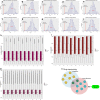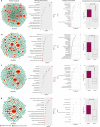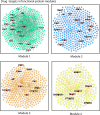Lung disease network reveals impact of comorbidity on SARS-CoV-2 infection and opportunities of drug repurposing
- PMID: 34535131
- PMCID: PMC8447809
- DOI: 10.1186/s12920-021-01079-7
Lung disease network reveals impact of comorbidity on SARS-CoV-2 infection and opportunities of drug repurposing
Abstract
Background: Higher mortality of COVID-19 patients with lung disease is a formidable challenge for the health care system. Genetic association between COVID-19 and various lung disorders must be understood to comprehend the molecular basis of comorbidity and accelerate drug development.
Methods: Lungs tissue-specific neighborhood network of human targets of SARS-CoV-2 was constructed. This network was integrated with lung diseases to build a disease-gene and disease-disease association network. Network-based toolset was used to identify the overlapping disease modules and drug targets. The functional protein modules were identified using community detection algorithms and biological processes, and pathway enrichment analysis.
Results: In total, 141 lung diseases were linked to a neighborhood network of SARS-CoV-2 targets, and 59 lung diseases were found to be topologically overlapped with the COVID-19 module. Topological overlap with various lung disorders allows repurposing of drugs used for these disorders to hit the closely associated COVID-19 module. Further analysis showed that functional protein-protein interaction modules in the lungs, substantially hijacked by SARS-CoV-2, are connected to several lung disorders. FDA-approved targets in the hijacked protein modules were identified and that can be hit by exiting drugs to rescue these modules from virus possession.
Conclusion: Lung diseases are clustered with COVID-19 in the same network vicinity, indicating the potential threat for patients with respiratory diseases after SARS-CoV-2 infection. Pathobiological similarities between lung diseases and COVID-19 and clinical evidence suggest that shared molecular features are the probable reason for comorbidity. Network-based drug repurposing approaches can be applied to improve the clinical conditions of COVID-19 patients.
Keywords: COVID-19; Comorbidity; Disease network; Lung disease; SARS-CoV-2.
© 2021. The Author(s).
Conflict of interest statement
The author declares he has no competing interests.
Figures






Similar articles
-
SAveRUNNER: A network-based algorithm for drug repurposing and its application to COVID-19.PLoS Comput Biol. 2021 Feb 5;17(2):e1008686. doi: 10.1371/journal.pcbi.1008686. eCollection 2021 Feb. PLoS Comput Biol. 2021. PMID: 33544720 Free PMC article.
-
Drug repurposing improves disease targeting 11-fold and can be augmented by network module targeting, applied to COVID-19.Sci Rep. 2021 Oct 19;11(1):20687. doi: 10.1038/s41598-021-99721-y. Sci Rep. 2021. PMID: 34667255 Free PMC article.
-
Discovery of common molecular signatures and drug repurposing for COVID-19/Asthma comorbidity: ACE2 and multi-partite networks.Cell Cycle. 2024 Feb;23(4):405-434. doi: 10.1080/15384101.2024.2340859. Epub 2024 Apr 19. Cell Cycle. 2024. PMID: 38640424 Free PMC article.
-
Repositioning of Drugs to Counter COVID-19 Pandemic - An Insight.Curr Pharm Biotechnol. 2021;22(2):192-199. doi: 10.2174/1389201021999200820155927. Curr Pharm Biotechnol. 2021. PMID: 32867651 Review.
-
Perspectives for repurposing drugs for the coronavirus disease 2019.Indian J Med Res. 2020 Feb & Mar;151(2 & 3):160-171. doi: 10.4103/ijmr.IJMR_585_20. Indian J Med Res. 2020. PMID: 32317408 Free PMC article. Review.
Cited by
-
Knowledge Graphs for drug repurposing: a review of databases and methods.Brief Bioinform. 2024 Sep 23;25(6):bbae461. doi: 10.1093/bib/bbae461. Brief Bioinform. 2024. PMID: 39325460 Free PMC article. Review.
-
Smoking status and SARS-CoV-2 infection severity among Lebanese adults: a cross-sectional study.BMC Infect Dis. 2022 Sep 24;22(1):746. doi: 10.1186/s12879-022-07728-1. BMC Infect Dis. 2022. PMID: 36153476 Free PMC article.
-
Differential Co-Expression Network Analysis Reveals Key Hub-High Traffic Genes as Potential Therapeutic Targets for COVID-19 Pandemic.Front Immunol. 2021 Dec 15;12:789317. doi: 10.3389/fimmu.2021.789317. eCollection 2021. Front Immunol. 2021. PMID: 34975885 Free PMC article.
References
MeSH terms
Substances
LinkOut - more resources
Full Text Sources
Medical
Miscellaneous

